Containers: Difference between revisions
No edit summary |
|||
| (25 intermediate revisions by the same user not shown) | |||
| Line 1: | Line 1: | ||
{{Languages|Containers}} | |||
''Next chapter-> [[Datapoint definition]]'' | ''Next chapter-> [[Datapoint definition]]'' | ||
==Phylosophy of containers== | ==Phylosophy of containers== | ||
The tree structure of the data points is based on containers. The containers are not data points of the physical subsection. Containers are logical parent nodes of physical datapoints or other containers. | |||
The containers always inherit the status of their childrens datapoints. | |||
[[Image:Tree_popup_newContainer.png|left|frame]] In tree view use the popup menu to create a new container. | |||
The | |||
[[Image:Tree_popup_newContainer.png|left|frame]] In tree use popup menu to create a new container. | |||
<br style="clear: both" /> | <br style="clear: both" /> | ||
==Physical containers== | ==Physical containers== | ||
[[Image:Tree_newcontainer.png|left|frame]] Physical container | [[Image:Tree_newcontainer.png|left|frame]] Physical container can be distinguished from a logical container, it features the communication protocol and the settings of corresponding subsystem(s). | ||
Optionally you can define the communication parameters after creating the container. These are parameters about IP address, subsystem type, port number... Datapoints from the subsystems' metafile can be imported under the physical container, as the physical containers children nodes. | |||
<br style="clear: both" /> | <br style="clear: both" /> | ||
==Logical containers== | ==Logical containers== | ||
[[Image:Tree_newlogcontainer.png|left|frame]]When you create a logical container | [[Image:Tree_newlogcontainer.png|left|frame]]When you create a logical container, the communication parameters have to be left blank. An arbitrary topology can be created of logical containers. Under a selected logical container an another one can be created in any number and depth. | ||
<br style="clear: both" /> | <br style="clear: both" /> | ||
==Datapoint reorganization== | ==Datapoint reorganization== | ||
Datapoints of subsystems can be defined under a physical container. Most of the time the import procedure (from a metafile) is automatic. | |||
To | Sometimes the inherited datapoint hierarchy is not arranged properly (illustrative) at the level of the supervisory system. To get a properly transparent, logical datapoint hierarchy, the datapoints from the physical containers can be moved under the logical containers. Any datapoint can be moved under any logical container. In a logical container you can mix different types of datapoints without any restriction. | ||
Important: | |||
[[Image: | Important: The datapoints are also linked to their original physical container. During a subsequent metafile import, datapoints that have already been moved to an other (logical) container are also updated. The metafile imports should always be initiated in its original physical container. | ||
[[Image:Tree_movedatapoint.png|left|frame]] In datapoint tree | [[Image:Engarbofa.jpg|left|frame]] Split your tree window. This makes it easier to drag&drop datapoints beetwen containers.<br style="clear: both" /> | ||
[[Image:Tree_movedatapoint.png|left|frame]] In datapoint tree view drag one or more datapoints from a physical container, and drop them to a logical container. Child nodes of the selected datapoints will also be moved to the new location. Logical containers will now inherit the status of their new chidren datapoints. | |||
<br style="clear: both" /> | <br style="clear: both" /> | ||
____ | |||
==Dedicated containers== | ==Dedicated containers== | ||
[[Image:Tree_container_set_dedicated_.png|left|frame]] | [[Image:Tree_container_set_dedicated_.png|left|frame]] In tree view right click on the container and from the popup menu select '''Edit container...'''. Check the "Dedicated" checkbox on the form.<br style="clear: both" /> | ||
[[Image:Tree_dedicated_button.png|left|caption]] | [[Image:Tree_dedicated_button.png|left|caption]] On the bottom of the event list window a container will appear. It will contain small lamps that reflect to the event categories and behave as collective signals of the children nodes of the corresponding container. Its caption is inherited from the first two letter of its container. | ||
<br style="clear: both" /> | <br style="clear: both" /> | ||
| Line 36: | Line 38: | ||
[[Category:Commissioning]] | [[Category:Commissioning]] | ||
{{Languages|Containers}} | |||
Latest revision as of 07:07, 12 April 2021
| Language: | English • magyar |
|---|
Next chapter-> Datapoint definition
Phylosophy of containers
The tree structure of the data points is based on containers. The containers are not data points of the physical subsection. Containers are logical parent nodes of physical datapoints or other containers. The containers always inherit the status of their childrens datapoints.
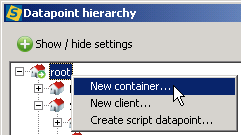
In tree view use the popup menu to create a new container.
Physical containers
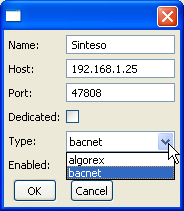
Physical container can be distinguished from a logical container, it features the communication protocol and the settings of corresponding subsystem(s).
Optionally you can define the communication parameters after creating the container. These are parameters about IP address, subsystem type, port number... Datapoints from the subsystems' metafile can be imported under the physical container, as the physical containers children nodes.
Logical containers
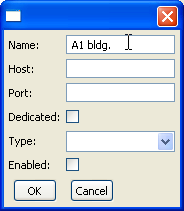
When you create a logical container, the communication parameters have to be left blank. An arbitrary topology can be created of logical containers. Under a selected logical container an another one can be created in any number and depth.
Datapoint reorganization
Datapoints of subsystems can be defined under a physical container. Most of the time the import procedure (from a metafile) is automatic. Sometimes the inherited datapoint hierarchy is not arranged properly (illustrative) at the level of the supervisory system. To get a properly transparent, logical datapoint hierarchy, the datapoints from the physical containers can be moved under the logical containers. Any datapoint can be moved under any logical container. In a logical container you can mix different types of datapoints without any restriction.
Important: The datapoints are also linked to their original physical container. During a subsequent metafile import, datapoints that have already been moved to an other (logical) container are also updated. The metafile imports should always be initiated in its original physical container.
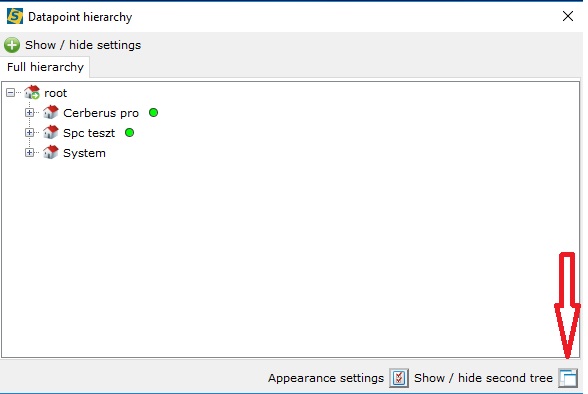
Split your tree window. This makes it easier to drag&drop datapoints beetwen containers.
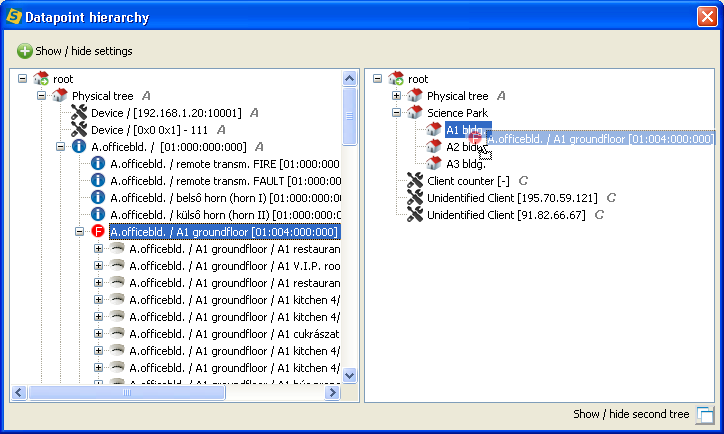
In datapoint tree view drag one or more datapoints from a physical container, and drop them to a logical container. Child nodes of the selected datapoints will also be moved to the new location. Logical containers will now inherit the status of their new chidren datapoints.
____
Dedicated containers
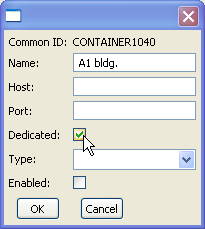
In tree view right click on the container and from the popup menu select Edit container.... Check the "Dedicated" checkbox on the form.

On the bottom of the event list window a container will appear. It will contain small lamps that reflect to the event categories and behave as collective signals of the children nodes of the corresponding container. Its caption is inherited from the first two letter of its container.
Next chapter-> Datapoint definition
| Language: | English • magyar |
|---|